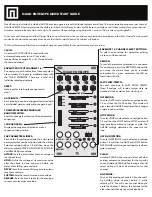
through the
Comp unchanged. This can be done in two ways:
by pushing the BYPASS switch
by connecting a footswitch to the BYPASS jack and pressing the footswitch.
On the back panel you will find a footswitch jack labelled BYPASS . This is a mono
jack with connections for a standard footswitch. The footswitch must be plugged
in before the
Comp has its power turned on: Comp will automatically recognise
the right "polarity" of the pedal.
4.3 Installation
a. Standard Use
The
Comp may be placed almost anywhere on a table, on top of an amp,
next to a mixing console. If it will be on furniture, check the rubber feet provided
9
b. Levels Setting
Proper setting of the input and output levels is crucial in order to achieve the maximum
signal- to-noise ratio. It is possible to say that it is usually best to set both input
and output level controls at 3/4 or 75% of full. This will decrease the possibility
of overload distortion and keep the amount of background noise to a minimum.
c. Compression Process Bypass
At any time you can bypass the process, there by allowing the direct signal to pass
also routed automatically to the RIGHT INPUT. However , if we are using
stereo input signals, connecting a cable to the RIGHT INPUT jack , the
automatic routing will be avoided and the LEFT INPUT jack will feed only
the LEFT INPUT, and the RIGHT INPUT jack will feed only the RIGHT INPUT.
If the Signal LED on the
Comp start lighting, signaling a process saturation,
turn down the Input level or decrease the volume of the source (instrument,
mixer send, etc.). If the
Comp's level is causing the mixer or amp to distort,
turn the Output Level down.
to the bottom of the unit. Make sure to place the
Comp's power supply away
from other audio equipment that may induce fields, and away from the signal wiring.
It is possible that
Comp may pick up noise field generated by other equipment
such as large power amplifiers; in this case, move the
Comp until the noise goes
away.









































